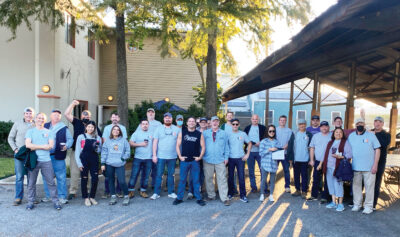Lumbermen on the West Coast say the market is good and they are busy – but getting product can be problematic.
A lumberman in Washington State considered his market to be good. “If you’ve got the product,” he stated, “it generally moves right out the door. That’s the case for sure right now. It’s good. However, it’s frustrating because of lack of supply.” Overall, he observed, the market is better than it was several months ago.
Species he sells include Poplar, Red and White Oak, Hard and Soft Maple and Hickory. Red Oak is the only quiet specie, he remarked. Thicknesses are mostly 4/4 – for flooring, cabinet parts and moulding. “It seems like the cabinet manufacturers are doing well,” he said. “They’re surprised that the volume is so good.”
Transportation, on the other hand, is “terrible,” he noted. “It’s hard to get trucks. It’s deteriorating.”
In California, a lumber provider said his market is good. “It’s very good,” he said. “I’d say it’s good enough that we’re having the same problems a lot of people are having with getting materials in. It’s not a problem sometimes selling right now; it’s having enough material in here. With ocean freight the way it is, we bring in some items from Europe – Estonia, Germany and Spain – and the containers get delayed. Even our Hardwood mills are having trouble with enough supply. We’re struggling there, too.”
He commented, “We’ve been discounting our invoices for 40 years and being nice to our vendors, and we still can’t get the lumber we need. It’s a challenge. Sometimes we call it PTSD – price to time of shipment disorder. That’s what we’re suffering with. It’s been like that for some time now. But this, too, will pass. We just don’t know when. And we hope not to be stuck with high inventory cost when it does turn around.”
Compared to a few months ago, monthly sales figures indicate the market is now “a little bit better,” he stated.
He sells all domestic species including Cherry, Maple, Poplar, Walnut, Red and White Oak, rift and quartered wood, up to 16/4 on certain items, upper grades and some rustic grades. “Years ago, we stocked some Common grades but not anymore,” he noted.
Customers are mostly lumberyards and manufacturers. Manufacturers are doing well, he stated, but lumberyards are having trouble getting lumber.
In transportation, trucks are somewhat problematic, he observed, but rail is not too bad.
Another California lumberman said, “Overall, the market’s still solid; we’re busy.” The market is the same as it was a few months earlier, he noted.
He sells White Oak, Walnut and Hickory in FAS No.1 and No. 2 Common to flooring companies, distribution yards and retail lumberyards. “Their business is solid,” he observed.
Transportation is not a problem for him, he stated. “We’re still fortunate.”
In Oregon, a source described the market as “robust. Just like everyone else, we’ve got shortages in certain areas. The economy has picked up and demand is good for our product. Supply is tight and prices are going up every week.”
Compared to several months earlier, the market is “absolutely better,” he remarked. “Six months ago, people were fearful due to COVID. I think one of the things that really helped in our industry was that the PPP funds assisted a lot of companies. In the end, they didn’t need it. But when we first came into this, we were all concerned that the wood products business was going to suffer as it has historically in every downturn. This downturn found, with more people working from home, that they did more projects and looked into remodeling.
“Other people are looking for a new home. We find that residents who were living downtown in high rise condominiums have moved to the suburbs. Real estate is tight. Prices are high. There’s just not a lot of product on the market. It’s been a surprisingly good marketplace. The problem is: can you replenish stock you’ve sold? There’s a lot of shortages and a lot of this is due to the fact that businesses can’t get additional labor to open another shift.”
He sells almost all uppers in most domestic species including Red and White Oak, Walnut, Maple, Cherry, Poplar, Basswood, Birch and Hickory. Customers include industrial accounts and other distributors. “I think everyone’s sales are strong right now through the whole lumber supply chain,” he stated.
Transportation is a problem, he remarked. “All I have to say is: where did all the trucking go?” he asked. “We see shortages in trucking out here as everyone ramps up for agriculture. We’re having trouble getting containers, too. On all transportation, rates are way up.”









